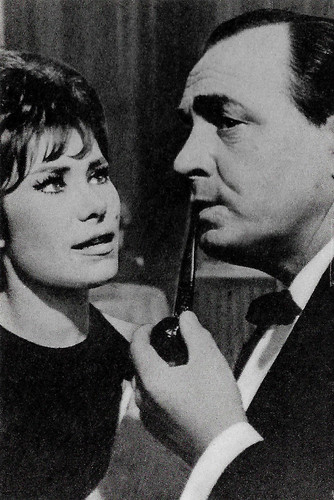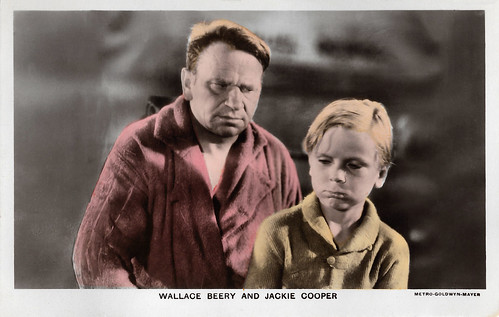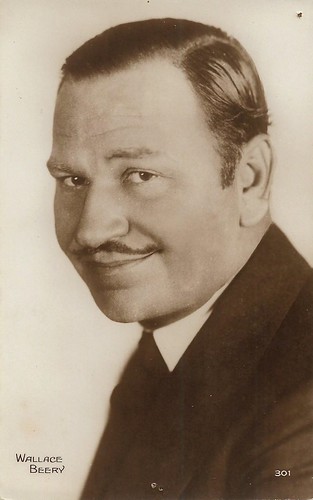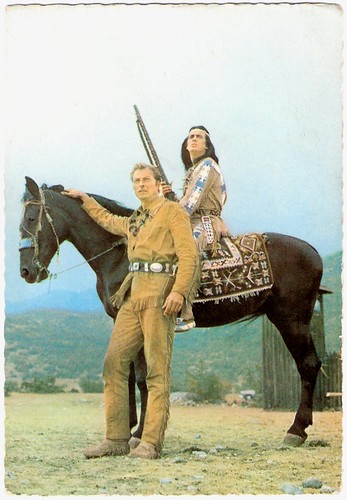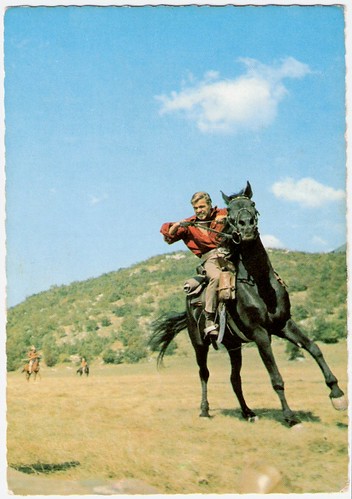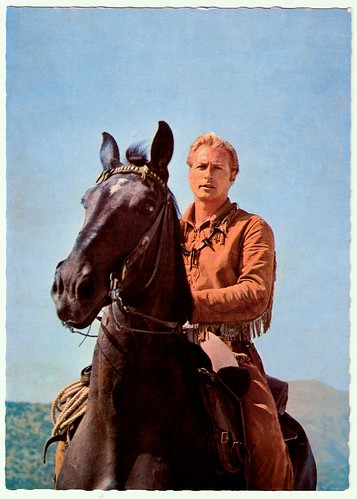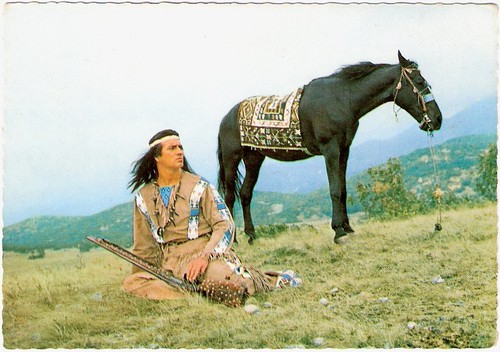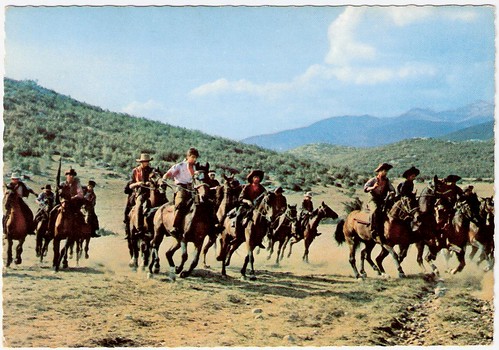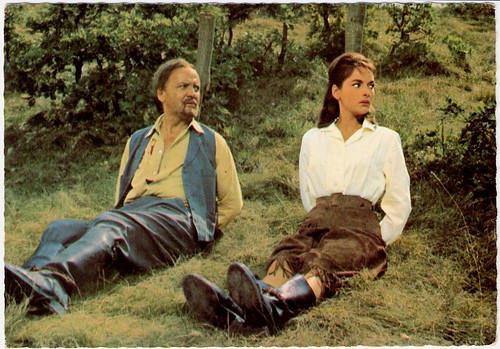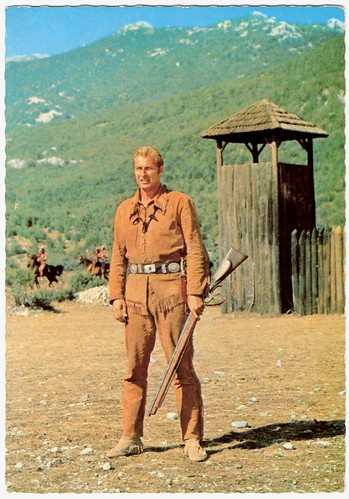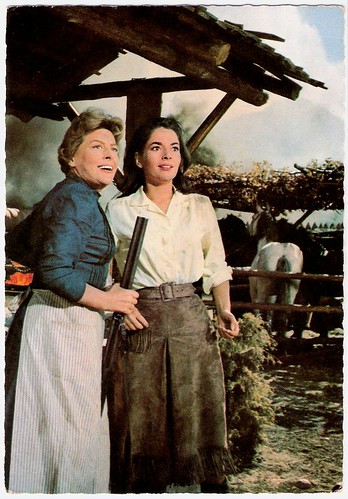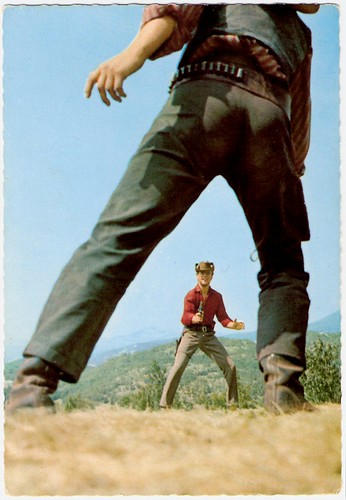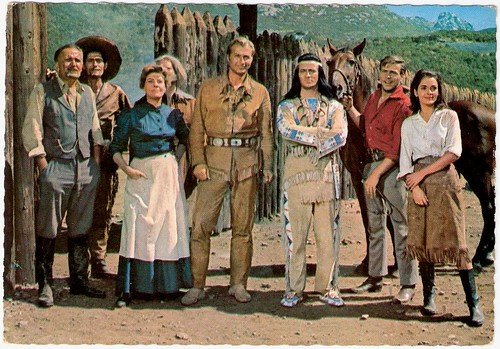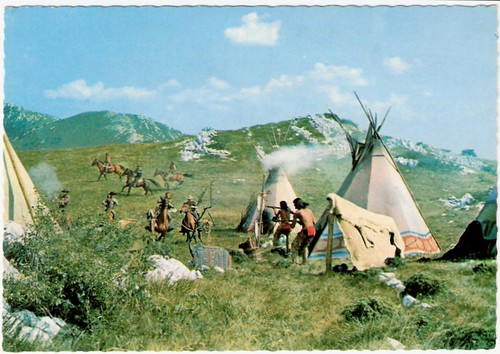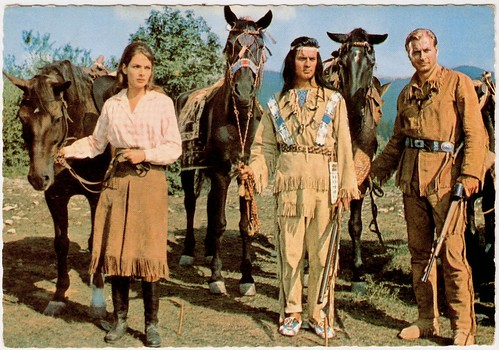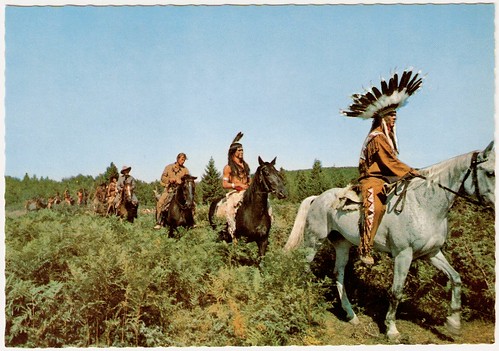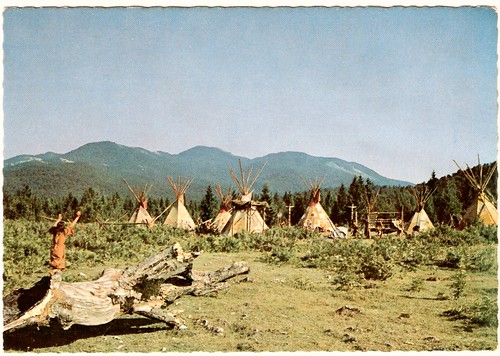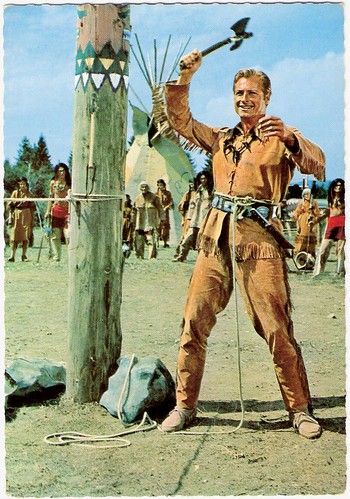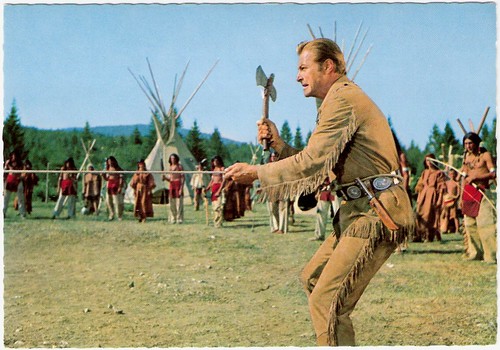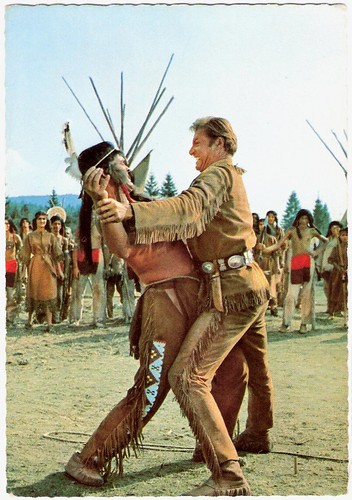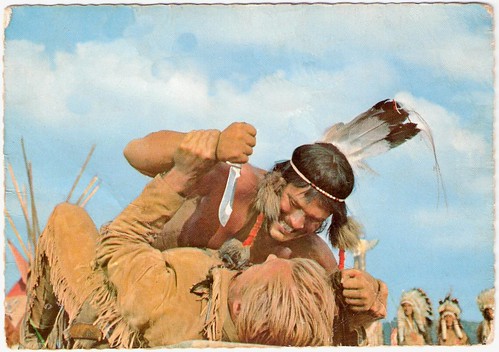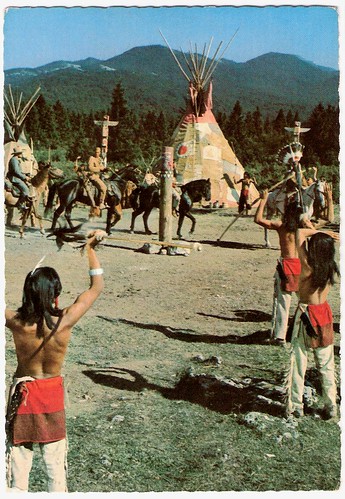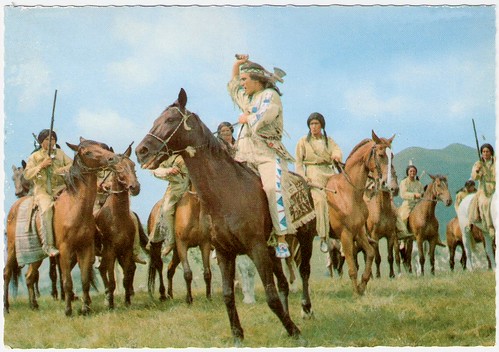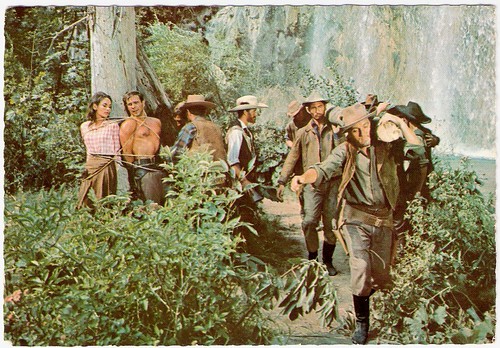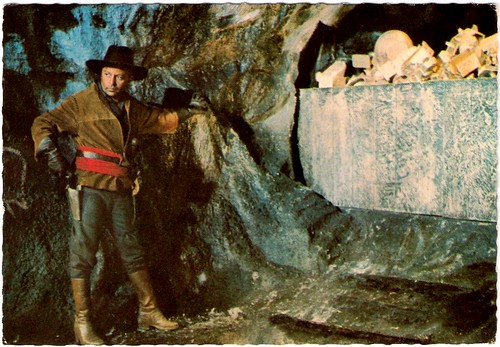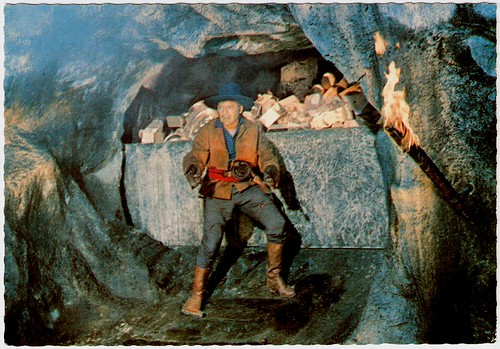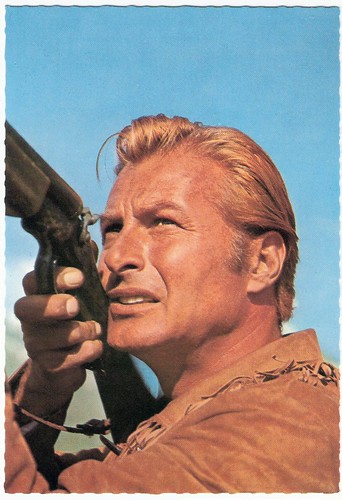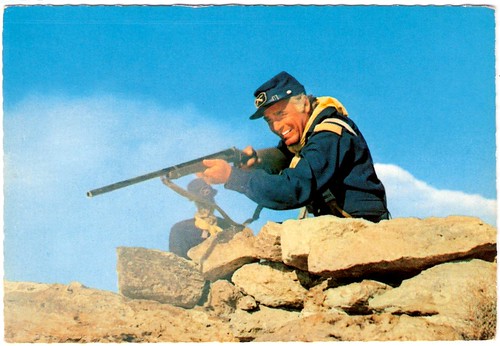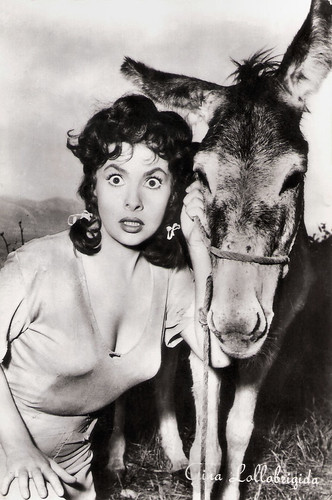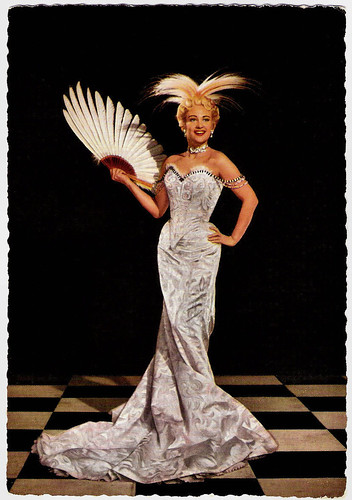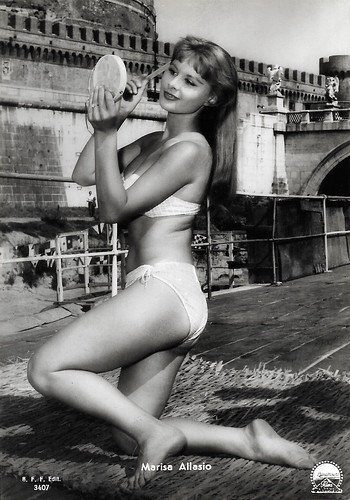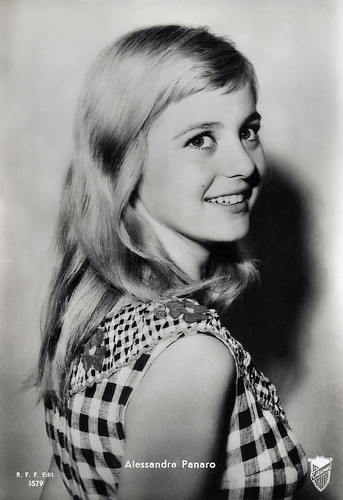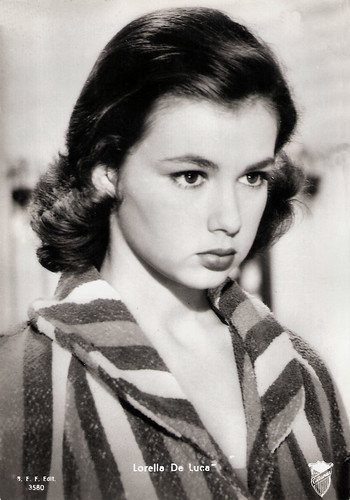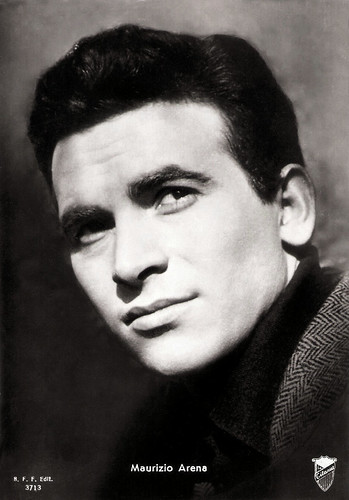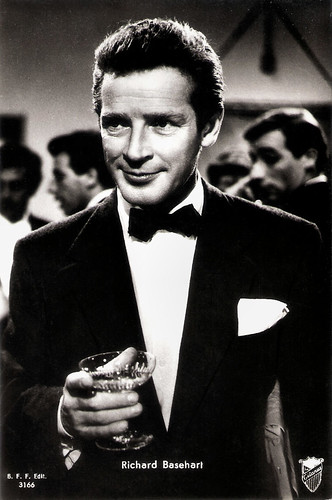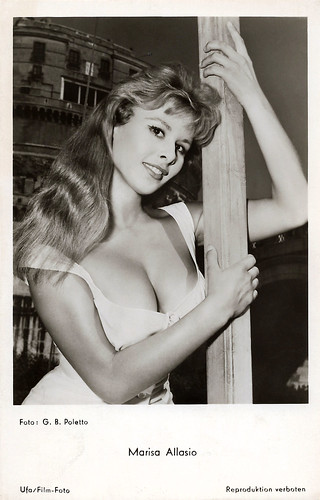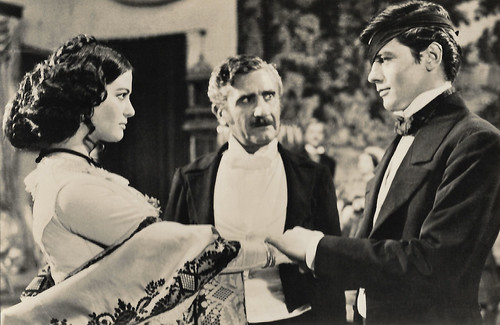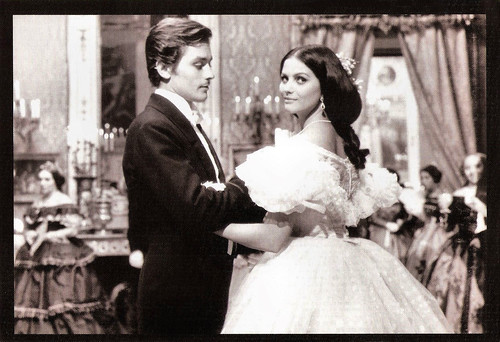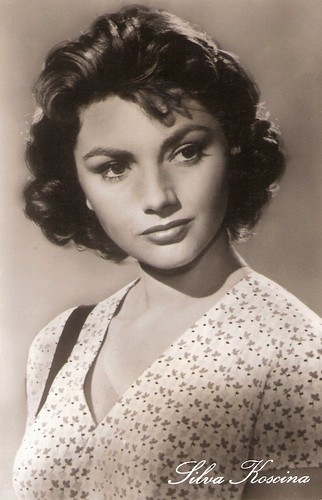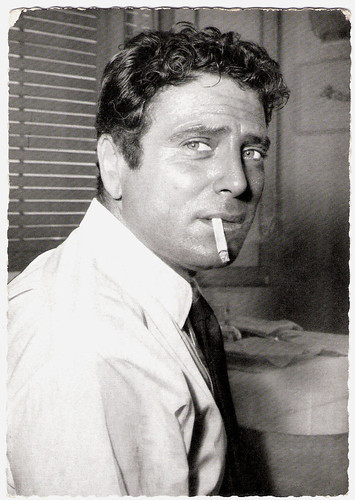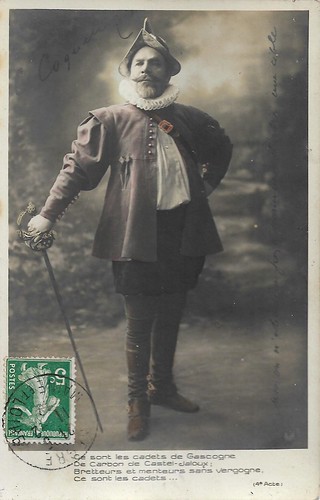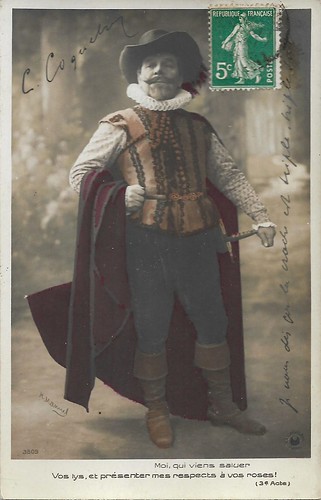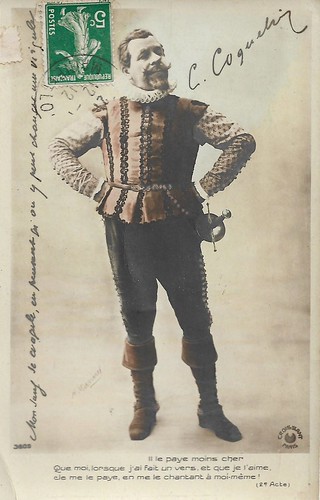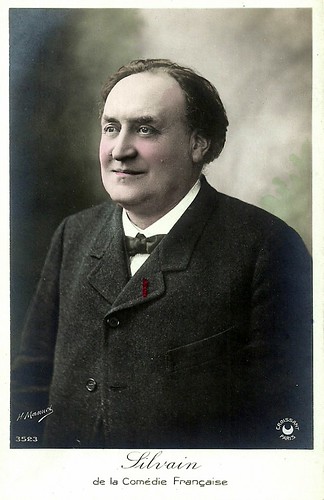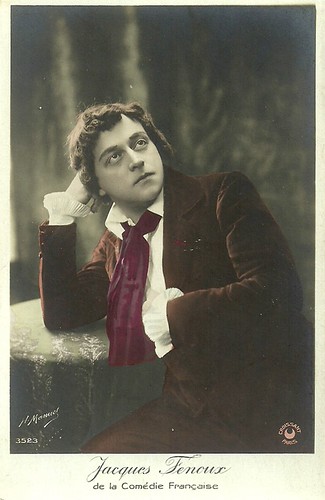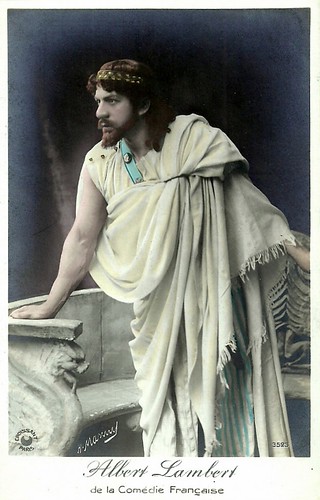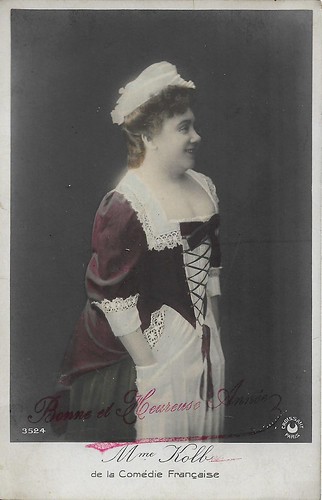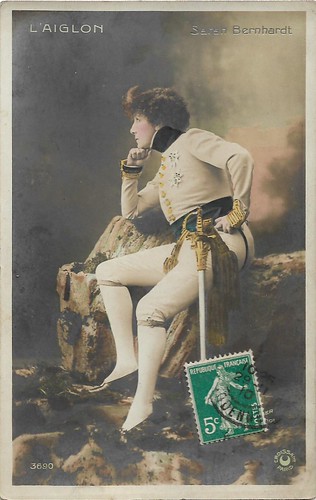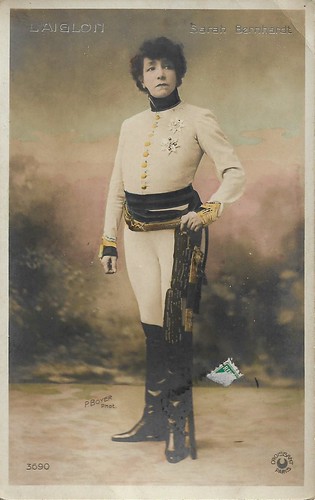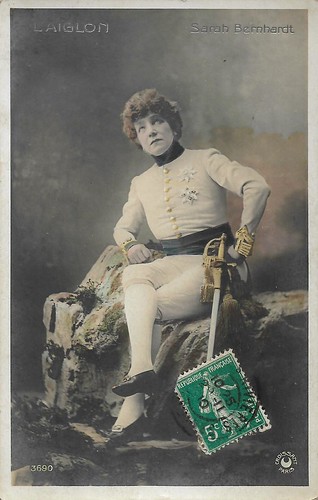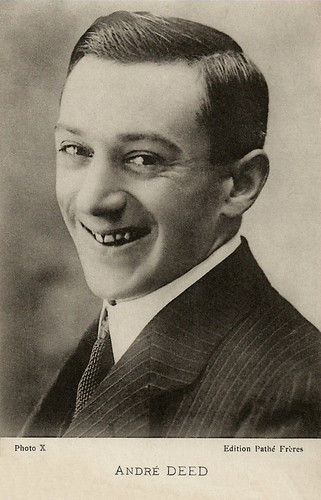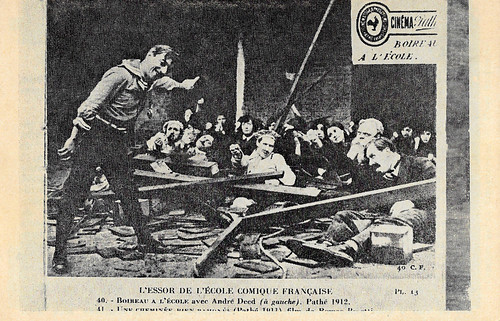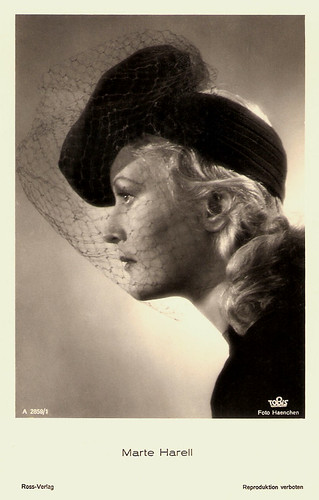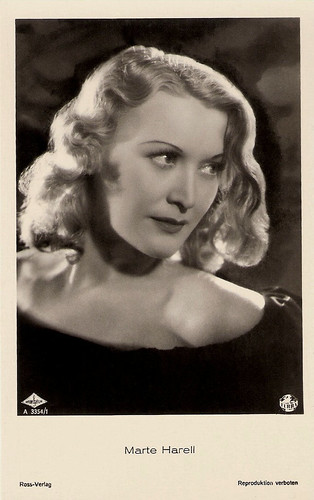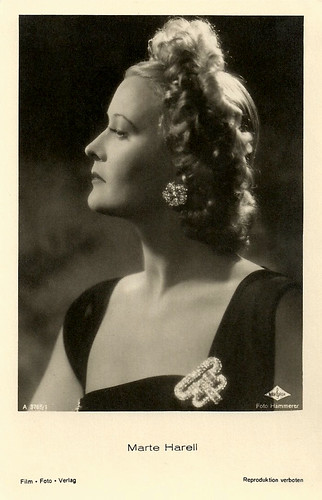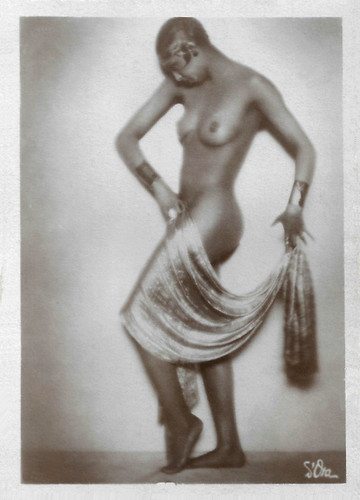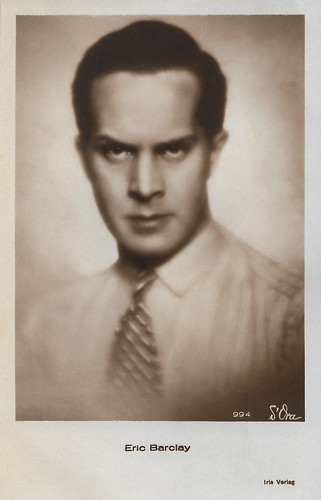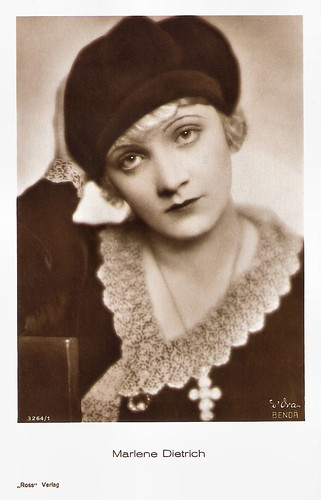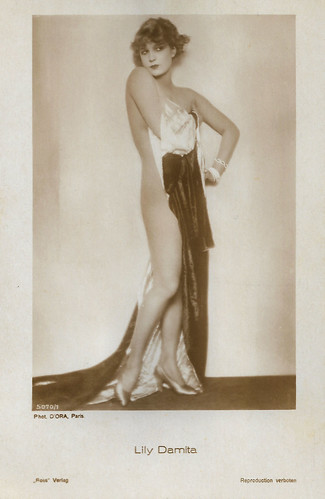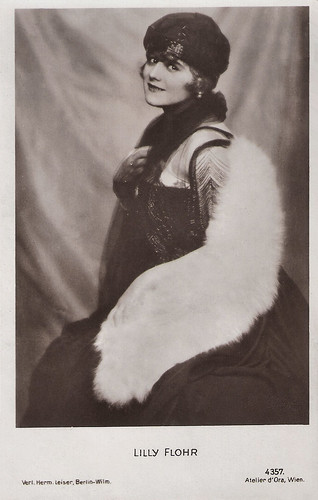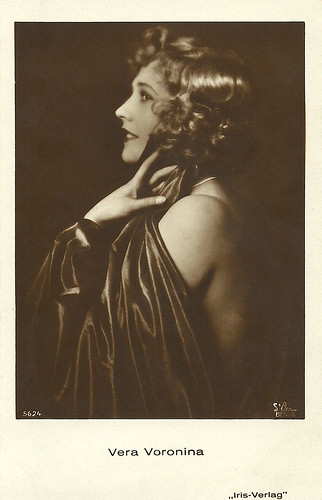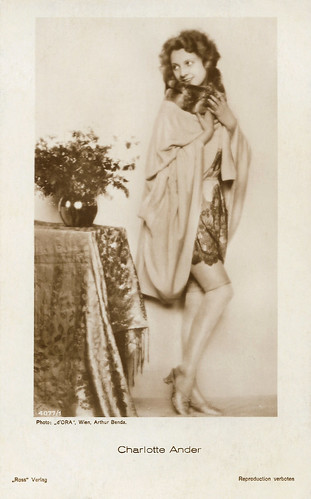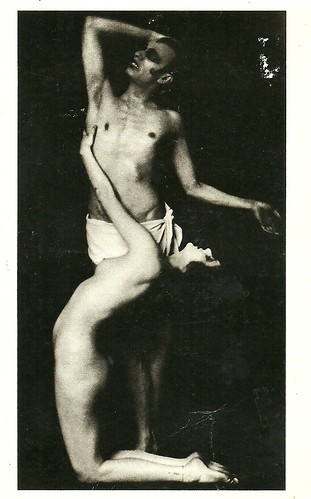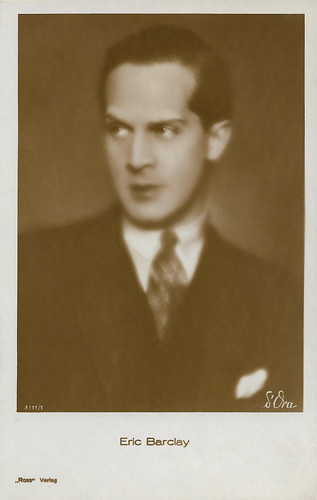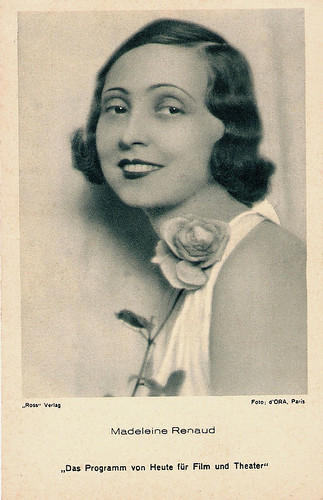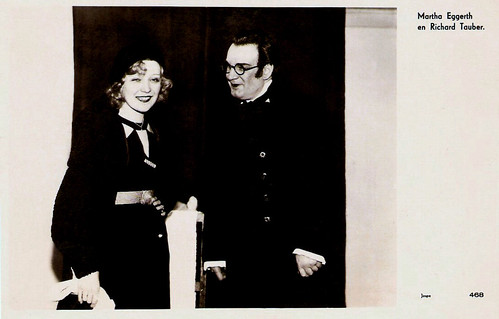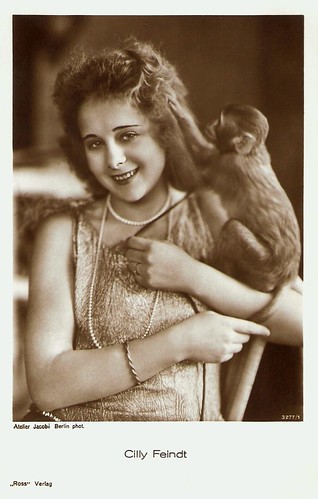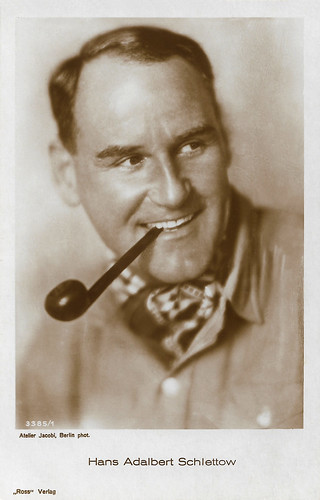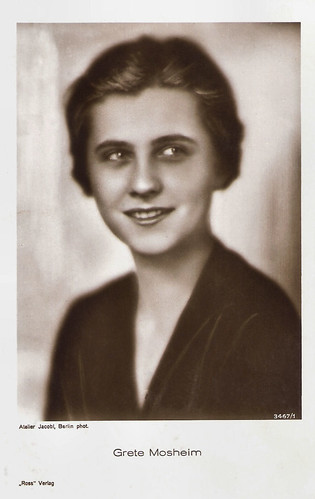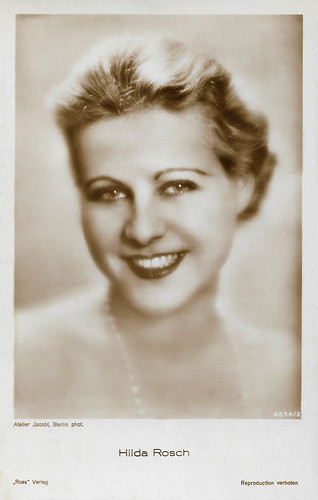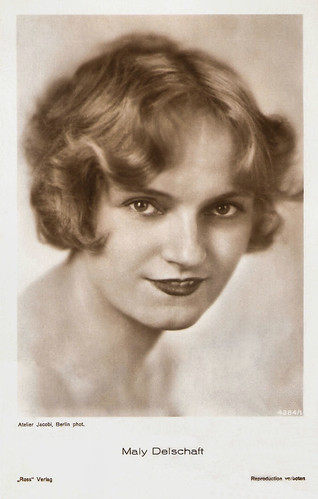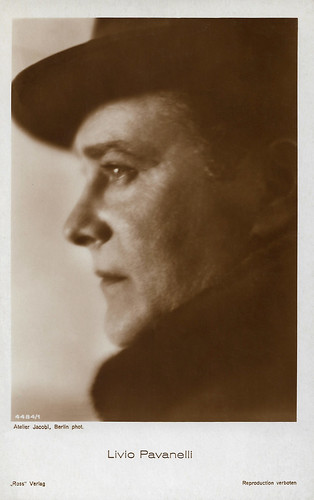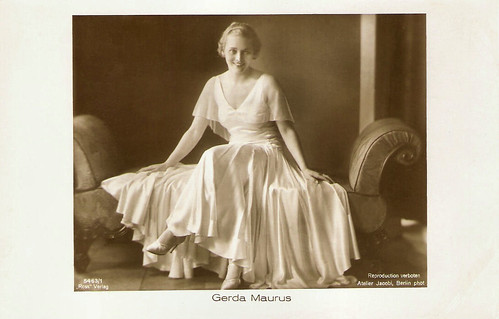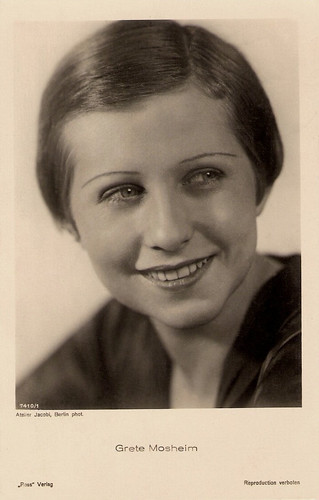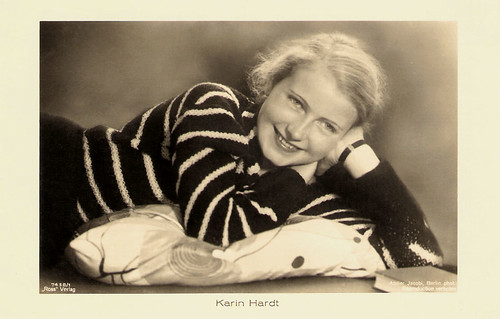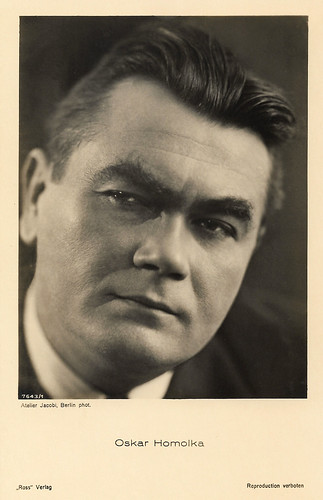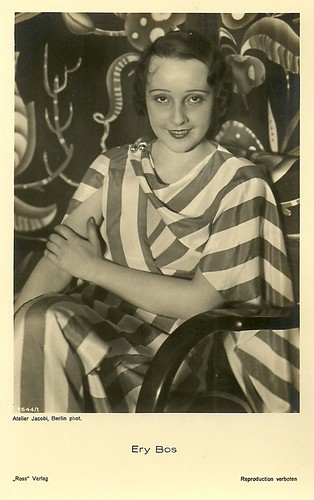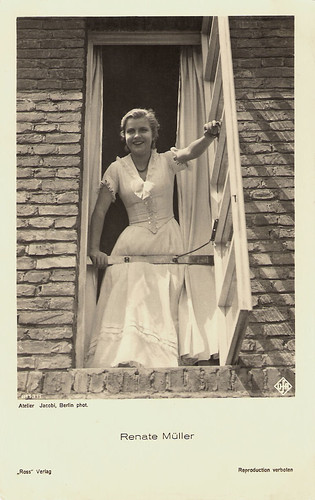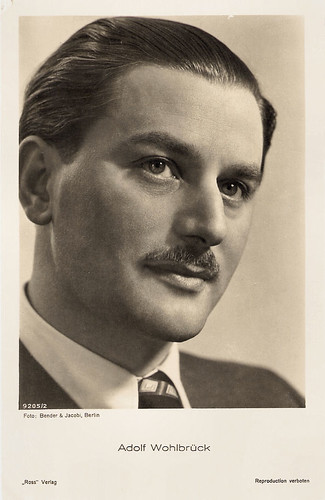The Eurowestern Der Letze Mohikaner/The Last Tomahawk (Harald Reinl, 1965) is one of the many film versions of the classic novel 'The Last of the Mohicans' by James Fenimore Cooper. It is a German-Italian-Spanish coproduction with stars like the Germans Joachim Fuchsberger and Karin Dor, Italian Anthony Steffen as Hawkeye and the Spanish actor Dan Martin as his friend Unkas, the last Mohican.![Dan Martin and Anthony Steffen in Der Letze Mohikaner (1965)]()
German postcard, no. 1 of 64. Photo: Constantin.
Dan Martin as Unkas and
Anthony Steffen as Hawkeye in
Der Letze Mohikaner/The Last Tomahawk (Harald Reinl, 1965). Caption: Unkas, the son of the Mohican chief Chingachook, rides over the country in the company of his white friend Hawkeye - known as 'the forest runner'. They do not know that the Iroquois, led by Magua and with the help of a white gang, raided the village of the Mohicans and massacred women and children. Badly injured, Chief Chingachook was still able to get on his horse and escape.
![Dan Martin, Mike Brendel and Anthony Steffen in Der Letzte Mohikaner (1965)]()
German postcard, no. 2 of 64. Photo: Constantin.
Dan Martin as Unkas,
Mike Brendel as Chingachgook and
Anthony Steffen as Hawkeye in
Der Letze Mohikaner/The Last Tomahawk (Harald Reinl, 1965). Caption: In the 'Garden of Stone Trees', Unkas and Hawkeye find Chingachook who was wounded to death. Dying, he tells his son Unkas about the fate of the Mohican tribe. At Chingachook's request, Hawkeye takes the chief's chain from him and puts on this Unkas, who thereby becomes the chief. Unkas - now the last Mohican - swears to his dying father that he will take revenge on Magua so that the souls of the murdered can enter the eternal hunting grounds. He also vows to take a woman home to revive the Mohicans.
![Anthony Steffen in Der Letzte Mohikaner (1965)]()
German postcard, no. 3 of 64. Photo: Constantin.
Anthony Steffen in
Der Lezte Mohikaner/The Last Tomahawk (Harald Reinl, 1965). Caption: Magua, who has watched Chingachook's escape and does not want a witness for his bloody deed, chases two Iroquois after the wounded Chingachook. With a bold leap, the watchful Hawkeye succeeds in killing one of the pursuers. However, the second can flee at the last moment.
![Dan Martin and Anthony Steffen in Der Letzte Mohikaner (1965)]()
German postcard, no. 4 of 64. Photo: Constantin.
Anthony Steffen and
Dan Martin in
Der Lezte Mohikaner/The Last Tomahawk (Harald Reinl, 1965). Caption: Hawkeye, the famous ranger, swears to his friend Unkas to help him find Magua. They want to atone for the act of blood. The escaped Iroquois will show them the way to Magua.
![Stelio Candelli and Ricardo Rodríguez in Der Letzte Mohikaner (1965)]()
German postcard, no. 5 of 64. Photo: Constantin.
Stelio Candelli as Roger and
Ricardo Rodríguez as Magua in
Der Letze Mohikaner/The Last Tomahawk (Harald Reinl, 1965). Caption: Magua celebrates his victory over the Mohicans - very against the will of the leader of the Desperados, Roger. Magua and Roger are by no means friends. They have allied only because they need mutual support for their criminal plans. So Roger now insists on fulfilling Magua's promise to help the gang raid Fort Westerhill. Roger demands the gold and, with a cynical smile, assures Magua of the scalp.
![Der Letzte Mohikaner (1965)]()
German postcard, no. 6 of 64. Photo: Constantin. Publicity still for
Der Letze Mohikaner/The Last Tomahawk (Harald Reinl, 1965). Caption: When crossing a ford, the money transport is attacked by Roger's gang and the Iroquois . A short but tough struggle takes victims on both sides. While the ammunition wagon falls into the hands of the gang, the surviving soldiers can save the wagon with the money to the nearby Munroe farm.
![Der Letzte Mohikaner (1965)]()
German postcard, no. 8 of 64. Photo: Constantin. Publicity still for
Der Letze Mohikaner/The Last Tomahawk (Harald Reinl, 1965). Caption: Roger's gang now turns to the farm. A hot fight begins. When Roger realises that the residents of the Farm are not giving up so quickly, he suggests to Munroe to do a barter: He demands the money and offers the captured ammunition wagon as a counter-solution.
![Carl Lange in Der Letzte Mohikaner (1965)]()
German postcard, no. 9 of 64. Photo: Constantin.
Carl Lange as Colonel Munroe in
Der Letze Mohikaner/The Last Tomahawk (Harald Reinl, 1965). Caption: Colonel Munroe, an old former officer, is outraged by this barter. Nevertheless, he is worried because his daughters Cora and Alice are on their way to the farm. It's a good thing they are under the protection of Captain Hayward, who is repairing a bridge with his troop!
![Joachim Fuchsberger in Der Letzte Mohikaner (1965)]()
German postcard, no. 10 of 64. Photo: Constantin.
Joachim Fuchsberger in
Der Letzte Mohikaner/The Last Tomahawk (Harald Reinl, 1965). Caption: This is Captain Hayward, a newcomer to the west, but a brave soldier. It seems easier for him to tackle rough terrain than to guard two young women like Cora and Alice.
![Joachim Fuchsberger in Der Letzte Mohikaner (1965)]()
German postcard, no. 11 of 64. Photo: Constantin.
Joachim Fuchsberger in
Der Letze Mohikaner/The Last Tomahawk (Harald Reinl, 1965). Caption: The bridge construction progressed under Hayward's command. They expect to be able to leave tomorrow. For this reason, Captain Hayward has already sent a mounted messenger to the farm to announce to Colonel Munroe that they will be arriving soon.
![Der Letzte Mohikaner]()
German postcard, no. 12 of 64. Photo: Constantin. Still for
Der Letze Mohikaner/The Last Tomahawk (Harald Reinl, 1965). Caption: As soon as the riding messenger gets near the farm, he is already surrounded by the Iroquois and Rogers gang. Whichever direction he turns, there is no escape for him!
![Stelio Candelli and Ricardo Rodríguez in Der Letzte Mohikaner (1965)]()
German postcard, no. 13 of 64. Photo: Constantin.
Stelio Candelli as Roger and
Ricardo Rodríguez as Magua in
Der Letze Mohikaner/The Last Tomahawk (Harald Reinl, 1965). Caption: The soldier sinks from his horse after being shot. Even torture does not make him speak. Then Roger discovers a note in the messenger bag.
![Stelio Candelli and Ricardo Rodríguez in Der Letzte Mohikaner (1965)]()
German postcard, no. 14 of 64. Photo: Constantin.
Stelio Candelli as Roger and
Ricardo Rodríguez as Magua in
Der Letze Mohikaner/The Last Tomahawk (Harald Reinl, 1965). Caption: When Roger reads the news about the sisters' coming arrival, a plan matures in him: Magua is said to be a false messenger from Colonel Munroe riding to the bridge and ambushing the trek. Above all, Roger warns Magua to take care of Cora and Alice to get them under his control. He's sure Colonel Munroe will trade the two girls for the gold!
![Der Letzte Mohikaner]()
German postcard, no. 17 of 64. Photo: Constantin. Still from
Der Lezte Mohikaner/The Last Tomahawk (Harald Reinl, 1965). Caption: The Iroquois not only fire with burning arrows but also threaten Captain Hayward with a knife and tomahawk.
![Joachim Fuchsberger in Der Letzte Mohikaner (1965)]()
German postcard, no. 19 of 64. Photo: Constantin.
Joachim Fuchsberger as Captain Hayward in
Der Letze Mohikaner/The Last Tomahawk (Harald Reinl, 1965). Caption: Captain Hayward realises too late that he has been trapped. As soon as they reach the boulder, they are attacked by a pack of Indians.
![Joachim Fuchsberger, Ricardo Rodriguez, Der Letzte Mohikaner]()
German postcard, no. 20 of 64. Photo: Constantin.
Joachim Fuchsberger as Captain Hayward and
Ricardo Rodriguez as Magua in
Der Letze Mohikaner/The Last Tomahawk (Harald Reinl, 1965). Caption: Die Irokesen schiessen nicht nur mit brennden Pfeilen, sondern bedrohen Captain Hayward auch mit Messer und Tomahawk.
A New European Film Genre
Der Letze Mohikaner, aka
El último Mohicano in Spain and
La valle delle ombre rosse in Italy, was filmed in 1964 in Almería in Andalucía (Spain), in La Ciudad Encantada, Cuenca (Spain) and in the CCC-Atelier in Berlin-Spandau, Germany.
It was distributed by Constantin, the German company which had produced the Western
Der Schatz im Silbersee/Treasure of Silver Lake (Harald Reinl, 1962). This successful
Karl May adaptation had lead to a new European film genre, the Eurowestern.
Harald Reinl had also directed the sequels
Winnetou - 1. Teil/Apache Gold (1963) and
Winnetou - 2. Teil/Last of the Renegades (1964) starring
Pierre Brice as Winnetou and
Lex Barker as Old Shatterhand, and now he was back to helm
Der Letzte Mohikaner (1965).
Co-producers of
Der Letzte Mohikaner were International Germania Film in Bonn, Producciones Cinematograficas Balcázar in Barcelona, Procusa Films in Madrid, and Cineproduzioni Associate Srl in Rome, so it was a real trans-European production.
Der Letze Mohikaner was based on the historical novel 'The Last of the Mohicans' by
James Fenimore Cooper Cooper, first published in 1826. It was one of the most popular English-language novels of its time and was the second book of the Leatherstocking Tales pentalogy and the best known.
The Pathfinder, published 14 years later in 1840, is its sequel.
Der Letze Mohikaner was the 13th film version of Fenimore Cooper's novel and there were still eight more film and TV versions to come. The 1920 version directed by
Clarence Brown and
Maurice Tourneur is well regarded, as is
George Brackett Seitz's 1936 version starring
Randolph Scott as Hawkeye.
The most recent version was also one of the best adaptations:
The Last of the Mohicans (Michael Mann, 1992), starring
Daniel Day Lewis as Hawkeye,
Madeleine Stowe as Cora Munro, and Inuit actor
Eric Schweig as Uncas. However many of the scenes from the 1992 film did not follow the book.
![Der Letzte Mohikaner (1965)]()
German postcard, no. 22 of 64. Photo: Constantin. Publicity still for
Der Letze Mohikaner/The Last Tomahawk (Harald Reinl, 1965). Caption: At the same time, more Iroquois rush in from the rocks and attack the remaining trek. Their arrows set the cars on fire. A hard fight man against man arises. It almost looks like this is the end of the command.
![Dan Martin in Der Letzte Mohikaner (1965)]()
German postcard, no. 24 of 64. Photo: Constantin.
Dan Martin in
Der Letze Mohikaner/The Last Tomahawk (Harald Reinl, 1965). Caption: Unkas emerged so suddenly and unexpectedly that Captain Hayward initially believes he is again facing an enemy. But Unkas' peaceful gesture convinces him that he has rushed in as a friend and helper. While Hawkeye is helping the soldiers, Unka supports Captain Hayward in the fight against the Iroquois.
![Karin Dor and Ricardo Rodriguez in Der Letzte Mohikaner (1965)]()
German postcard, no. 25 of 64. Photo: Constantin.
Karin Dor and
Ricardo Rodriguez in
Der Letze Mohikaner/The Last Tomahawk (Harald Reinl, 1965). Caption: Now Magua intervenes. The moment has come for him to kidnap Cora. He ruthlessly drives her deeper into the mountains through rough terrain. But Unkas has observed the incident and is following his arch-enemy!
![Ricardo Rodriguez in Der Letzte Mohikaner (1965)]()
German postcard, no. 26 of 64. Photo: Constantin.
Ricardo Rodriguez in
Der Letze Mohikaner/The Last Tomahawk (Harald Reinl, 1965). Caption: When Magua realises that Unkas is chasing him, he brings Cora to safety behind a rock and shoots what the iron has to offer. He now hopes to get the last of the Mohicans out of the way.
![Daniel Martin and Ricardo Rodríguez in Der Letzte Mohikaner (1965)]()
German postcard, no. 27 of 64. Photo: Constantin.
Dan Martin as Unkas and
Ricardo Rodríguez as Magua in
Der Letze Mohikaner/The Last Tomahawk (Harald Reinl, 1965). Caption: Unkas takes cover. Yes, he even manages to stalk so close to his enemy that he comes into a duel. Just to save Cora's life, he refrains from killing Magua.
![Karin Dor and Dan Martin in Der Letzte Mohikaner (1965)]()
German postcard, no. 28 of 64. Photo: Constantin.
Dan Martin as Unkas and
Karin Dor as Cora Munroe in
Der Letze Mohikaner/The Last Tomahawk (Harald Reinl, 1965). Caption: Unkas frees Cora from her bonds. Both immediately gain great trust in one another. When asked about his family, Unkas tells of the sad end of his tribe.
![Karin Dor and Daniel Martin in Der letzte Mohikaner (1965)]()
German postcard, no. 29 of 64. Photo: Constantin.
Dan Martin and
Karin Dor in
Der Lezte Mohikaner/The Last of the Mohicans (Harald Reinl, 1965). Caption: Unkas leads Cora onto a high plateau. This is the place where he wants to meet Falenauge. He knows that Hawkeye will safely guide the rest of the small group here.
![Dan Martin and Anthony Steffen in Der Letzte Mohikaner (1965)]()
German postcard, no. 30 of 64. Photo: Constantin.
Dan Martin as Unkas and
Anthony Steffen as Hawkeye in
Der Letze Mohikaner/The Last Tomahawk (Harald Reinl, 1965). Caption: The survivors are already approaching, the wounded supported by the unsecured. The sisters cry for joy in their arms. But there is no rest because the pursuers are on the trail. It is decided to resort to a trick to take possession of the horses that have fallen into the hands of the Iroquois. Here Captain Hayward is said to play a major role. His brave struggle against the Indians earned him the honorary name 'Harder than Iron'.
![Der Letzte Mohikaner (1965)]()
German postcard, no. 31 of 64. Photo: Constantin. Publicity still in
Der Letze Mohikaner/The Last Tomahawk (Harald Reinl, 1965). Caption: The fight for the Munroe Farm continues. Young Henry wanted to get help and broke out of the farm. Bullets hit him barely a few steps away. Mortally wounded, he can save himself in the farm. Now the besieged know that there is no escape.
![Joachim Fuchsberger, Der Letzte Mohikaner]()
German postcard, no. 32 of 64. Photo: Constantin.
Joachim Fuchsberger in
Der Letzte Mohikaner/The Last Tomahawk (Harald Reinl, 1965). Caption: It is part of the List's plan that Captain Hayward draws the attention of the Iroquois. Hidden behind rocks, he shoots several rifles one after the other to fake a group of soldiers. In the meantime, the cook leads the small group to 'the garden of the stone trees' to bring the survivors to safety.
![Der Letzte Mohikaner]()
German postcard, no. 33 of 64. Photo: Constantin. Still for
Der Letze Mohikaner/The Last Tomahawk (Harald Reinl, 1965). Caption: The Iroquois storm the mountain: they are certain of their final victory, but once they reach the plateau, they become aware of the deception they have fallen victim to! Captain Hayward was able to save himself by jumping off the rock at the last minute.
![Dan Martin in Der Letzte Mohikaner (1965)]()
German postcard, no. 34 of 64. Photo: Constantin.
Dan Martin as Unkas in
Der Letze Mohikaner/The Last Tomahawk (Harald Reinl, 1965). Caption: Meanwhile, Unkas and Hawkeye have come to the horses. They catch enough animals and scare the rest off with pistol shots. This gives them a head start on the Iroquois.
![Karin Dor, Marie France and Kurt Grosskurth in Der letzte Mohikaner (1965)]()
German postcard, no. 35 of 64. Photo: Constantin.
Marie France,
Karin Dor and
Kurt Grosskurth in
Der Lezte Mohikaner/The Last of the Mohicans (Harald Reinl, 1965). Caption: The chef has led the small group to the 'Garden of Stone Trees'. What a joy when Captain Hayward emerges intact and soon after Uncas and Hawk-Eye with the horses. Now they can leave for Munroe's Farm!
![Karin Dor and Daniel Martin in Der letzte Mohikaner (1965)]()
German postcard, no. 36 of 64. Photo: Constantin.
Karin Dor and
Dan Martin in
Der Lezte Mohikaner/The Last of the Mohicans (Harald Reinl, 1965). Caption: Unkas knows every way in his country from numerous hunts. He leads the small group closer and closer to Munroe Farm on unknown paths.
![Der Letzte Mohikaner (1965)]()
German postcard, no. 38 of 64. Photo: Constantin. Publicity still in
Der Letze Mohikaner/The Last Tomahawk (Harald Reinl, 1965). Caption: The fight for the farm continues. With horror, the besieged have to realise that the Iroquois army has now returned. Will they be able to withstand another rush? How long will the ammunition supply last?
![Daniel Martin, Anthony Steffen and Karin Dor in Der letzte Mohikaner (1965)]()
German postcard, no. 39 of 64. Photo: Constantin.
Dan Martin,
Anthony Steffen and
Karin Dorin
Der Lezte Mohikaner/The Last of the Mohicans (Harald Reinl, 1965). Caption: Kurz von der Munroe-Farm, im Schutze der Felsen, macht die kleine Gruppe halt. Sie überzeugt sich davon, dass die Farm von Rogers bande und den Irokesen umzingelt ist. Wie sollen sie nun hinein gelangen? Wiederum verfällt man auf eine Liste. Wie früher der Oberst, wenn er nach Hause zurück kehrte, mit einem Roten Tuch winkte, genauso soll sich Unkas der Farm nähern, damit man seine friedlichen Absichten erkennt. Cora bindet Unkas ihr rotes Halstuch um den Arm. (Near the Munroe farm, in the shelter of the rocks, the small group makes halt. They convinced themselves that the farm of Rogers bande and the Iroquois is surrounded. But how can they get inside? Again, one falls on a list. As before the colonel, when he returned home, Unkas will wave a red cloth when he goes nearer to the farm, so that you can see his peaceful intentions. Cora binds her red scarf around Unkas arm.)
![Dan Martin in Der Letzte Mohikaner (1965)]()
German postcard, no. 40 of 64. Photo: Constantin.
Dan Martin as Unkas in
Der Letze Mohikaner/The Last Tomahawk (Harald Reinl, 1965). Caption: Unkas rides through the ranks of the Iroquois undetected. Then he gallops towards the Monroe Farmgate. Only now do the Indians recognise their enemy and pursue him.
Story of the Novel versus the story of the film
The story of the novel takes place in 1757 during the Seven Years' War (known in America as the French and Indian War), when France and the United Kingdom battled for control of the American and Canadian colonies. During this war, the French often allied themselves with Native American tribes in order to gain an advantage over the British, with unpredictable and often tragic results.
The story is set in the British province of New York and concerns a Huron massacre (with passive French acquiescence) of from 500 to 1,500 Anglo-American troops, who had honorably surrendered at Fort William Henry, plus some women and servants; the kidnapping of two sisters, daughters of the British commander; and their rescue by the last two Mohicans, and others.
In the film version
Der Letze Mohikaner, Alice (
Marie-France) and Cora Munro (
Karin Dor) attempt to find their father (
Carl Lange), a British officer in the French and Indian War. They are set upon by French soldiers and their cohorts, Huron tribesmen led by the evil Magua (
Ricardo Rodriquez).
Fighting to rescue the women are chief Chingachgook and his son Unkas (
Daniel Martín aka
Dan Martin), the last of the Mohican tribe, and their white ally, the frontiersman Natty Bumppo, known as Falkenauge/Hawkeye (
Anthony Steffen).
The other hero of the film is Captain Hayward, played by German actor
Joachim Fuchsberger.
Ma Cortes at
IMDb reviews the film: "This is an exciting film, plenty of action, thrills, fights, love and breathtaking outdoors from Almeria. Acceptable action sequences with rousing attacks and spectacularly realistic battles. Charismatic performance for all casting. The notorious Spaghetti actor,
Anthony Steffen is good as Hawkeye and
Karin Dor, director's wife is wonderful. Special mention to
Daniel Martín as honorable Unkas and
Ricardo Rodriguez as Magua as an appropriately villainous in a powerful performance. Look for secondary actors usual of Spaghetti Western as
Frank Braña,
Rafael Hernandez and
Chris Huerta, among others. Colorful cinematography by
Francisco Marin reflecting splendidly the sunny exteriors from the haunted city of Cuenca and Almeria wherein the '60s and '70s were shot hundreds of Spaghetti Westerns." (Why Steffen would be 'notorious' is not clear to me.)
The film was not a huge success though, but the novel stayed popular. The phrase 'the last of the Mohicans' has now been used often proverbially to refer to the sole survivor of a noble race or type. In 2011,
The Last of the Mohicans was parodied as
The Last of the Meheecans in the popular animated series
South Park. In this episode, the character of Butters, who has become lost in the woods after playing Border Patrol with the other boys, finds himself to be the 'last of the Meheecans' (meaning Mexicans on his team).
![Anthony Steffen in Der Letzte Mohikaner (1965)]()
German postcard, no. 41 of 64. Photo: Constantin.
Anthony Steffen as Hawkeye in
Der Letze Mohikaner/The Last Tomahawk (Harald Reinl, 1965). Caption: But Hawkeye already intervenes as agreed! He deliberately draws attention to distract the Iroquois and bandits from Unkas. The trick works. Initially unnoticed by the Iroquois, Hawkeye directs its pursuers in the opposite direction of the Munroe Farm. The way to the farm is clear.
![Der Letzte Mohikaner (1965)]()
German postcard, no. 42 of 64. Photo: Constantin. Publicity still in
Der Letze Mohikaner/The Last Tomahawk (Harald Reinl, 1965). Caption: Colonel Munroe, recognising the red cloth, opens the gate. Unkas storms into the farm, closely followed by Cora, Alice, and the soldiers. Colonel Munroe happily embraces his daughters.
![Joachim Fuchsberger in Der letzte Mohikaner (1965)]()
German postcard, no. 43 of 64. Photo: Constantin.
Joachim Fuchsberger as Captain Hayward in
Der Letzte Mohikaner/The Last Tomahawk (Harald Reinl, 1965). Caption: Captain Hayward gives the final cover to the riders. However, before he can get to safety, an arrow hits him; because the Iroquois watched the diversion. They let go of Hawkeye and turn furiously to the Munroe Farm. Captain Hayward reached the palisade wall at the last minute in the fire protection of the farm dwellers.
![Joachim Fuchsberger and Marie France in Der Letzte Mohikaner]()
German postcard, no. 44 of 64. Photo: Constantin.
Joachim Fuchsberger as Captain Hayward and
Marie France as Alice in
Der Letzte Mohikaner/The Last Tomahawk (Harald Reinl, 1965). Caption: Captain Hayward's iron nature quickly overcomes the serious injury. Alice is particularly happy about his rescue and early recovery.
![Ricardo Rodríguez and Stelio Candelli in Der Letzte Mohikaner (1965)]()
German postcard, no. 45 of 64. Photo: Constantin.
Ricardo Rodríguez as Magua and
Stelio Candelli as Roger in
Der Letze Mohikaner/The Last Tomahawk (Harald Reinl, 1965). Caption: Roger is furious when he realises that he has been outwitted. He makes the bitterest reproaches against Magua for his failure. Since the residents of the farm do not give up, Roger makes a devilish plan: he wants to blow up the rock towering over the Munroe farm in order to destroy the farm and its inhabitants. Then finally the way to gold is clear!
![Karin Dor and Daniel Martin in Der letzte Mohikaner (1965)]()
German postcard, no. 47 of 64. Photo: Constantin.
Karin Dor and
Dan Martin in
Der Lezte Mohikaner/The Last of the Mohicans (Harald Reinl, 1965). Caption: The silence around Munroe Farm worries Unkas. But his natural instinct helps him recognise the plan. Cora, clarified by Unkas about the trickery of Roger's gang, watches the hustle and bustle.
![Der Letzte Mohikaner (1965)]()
German postcard, no. 50 of 64. Photo: Constantin. Publicity still for
Der Letze Mohikaner/The Last Tomahawk (Harald Reinl, 1965). Caption: The Iroquois and Roger's gang are already storming the farm. A bitter struggle ensues. It looks like this is the end of the farm dwellers.
![Ricardo Rodriquez]()
German postcard, no. 52 of 64. Photo: Constantin.
Ricardo Rodriquez in
Der Letze Mohikaner/The Last Tomahawk (Harald Reinl, 1965). Caption: Despite the tough fight, Magua was on the post. Taking advantage of the effects, he kidnaps Cora a second time.
![Dan Martin in Der Letzte Mohikaner (1965)]()
German postcard, no. 53 of 64. Photo: Constantin.
Dan Martin in
Der Lezte Mohikaner/The Last Tomahawk (Harald Reinl, 1965). Caption: Trotz des Kampfgetümmels ist Unkas das Vorgehen seines Feindes Magua nicht entgangen. Er kämpft sich frei und nimmt Maguas Spur auf. (Despite the battle tumult, Unkas did not fail to notice the actions of his enemy Magua. He fights his way free and takes Maguas track.)
![Dan Martin and Anthony Steffen in Der Letzte Mohikaner (1965)]()
German postcard, no. 54 of 64. Photo: Constantin.
Dan Martin as Unkas and
Anthony Steffen as Hawkeye in
Der Letze Mohikaner/The Last Tomahawk (Harald Reinl, 1965). Caption: Hawkeye followed his friend Unkas. Both know that they are now facing a difficult path and will make an important decision.
![Dan Martin]()
German postcard, no. 56 of 64. Photo: Constantin.
Dan Martin in
Der Lezte Mohikaner/The Last Tomahawk (Harald Reinl, 1965). Caption: Unkas asks the old and wise Chief for advice: he does not want hatred, because he believes that white and red can live side by side undisturbed in the same country.
![Ricardo Rodríquez in Der Letzte Mohikaner (1965)]()
German postcard, no. 57 of 64. Photo: Constantin.
Ricardo Rodríquez as Magua in
Der Lezte Mohikaner/The Last Tomahawk (Harald Reinl, 1965). Caption: Magua also expressed his point of view. He hates the white people who have taken the country from him and his brothers. In every Indian who fraternises with the whites, he sees a traitor. That is why Unkas is an enemy for him.
![Daniel Martin in Der Letzte Mohikaner]()
German postcard, no. 58 of 64. Photo: Constantin.
Dan Martin in
Der Lezte Mohikaner/The Last Tomahawk (Harald Reinl, 1964). Caption: The wise chief has heard both. He asked it the great Manitou. The judgment of the God is: a duel will decide about life and death.
![Daniel Martin and Ricardo Rodríguez in Der Letzte Mohikaner (1965)]()
German postcard, no. 60 of 64. Photo: Constantin.
Dan Martin and
Ricardo Rodríguez in
Der Letze Mohikaner/The Last Tomahawk (Harald Reinl, 1965). Caption: The two arch-enemies face each other in a ritual duel. The guns hit the shields hard. Who will be the winner?
![Dan Martin, Roberto Rodriquez]()
German postcard, no. 63 of 64. Photo: Constantin.
Dan Martin and
Ricardo Rodríquez in
Der Lezte Mohikaner/The Last Tomahawk (Harald Reinl, 1965). Caption: Both, already wounded, continue to fight fiercely. Unkas succeeds in forcing Magua onto her back. He could kill him with a spear but his hatred has evaporated. Leaving the vanquished on the ground, he turns to the young man. Magua cannot overcome his defeat. He kills Unkas from behind by throwing a javelin. The last Mohawk collapses dead.
![Ricardo Rodriques in Der Letzte Mohikaner (1965)]()
German postcard, no. 63 of 64. Photo: Constantin.
Ricardo Rodríguez in
Der Lezte Mohikaner/The Last Tomahawk (Harald Reinl, 1965). Caption: Magua knows that his end is here. The old chief speaks to him from the tribal honor and grants him three drum roll lead to flee. But Magua does not move. After the third drum roll, the arrows of the archers knit him down. Besides Uncas he finds death.
![Dan Martin in Der Letzte Mohikaner (1965)]()
German postcard, no. 64 of 64. Photo: Constantin.
Dan Martin in
Der Letze Mohikaner/The Last Tomahawk (Harald Reinl, 1965). Caption: That was Unkas, the last Mohican. He won and still lost his life. The death of his brothers is avenged: the way to the Eternal Hunting Grounds is free for the Mohicans!
Sources:
Filmportal.de (German),
AllMovie, Wikipedia (
German and
English), and
IMDb.
![Senta Berger in Operazione San Gennaro (1966)]()
![Sabine Sinjen and Hans-Dieter Schwarze in Alle Jahre wieder (1967)]()
![Pavlina Filipovská and Václav Neckár in Ta nase písnicka ceská (1967)]()
![Monika Gabriel in Wir lassen uns scheiden (1968)]()
![Marie-José Nat and Alexandru Herescu in Dacii (1966)]()
![Manfred Krug in Hauptmann Florian von der Mühle (1968)]()
![Kai Fischer and Paul Klinger in Das Wirtshaus von Dartmoor (1964)]()
![Der Mord, der nie verjährt (1968)]()
![Carroll Baker, Dolores Del Rio, and Ricardo Montalban in Cheyenne Autumn (1964)]()
![Neu im Kino]()






